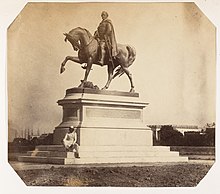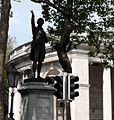John Henry Foley
John Henry Foley | |
|---|---|
Royal Academy Schools , (1835-38) | |
| Known for | Sculpture |
John Henry Foley
While much contemporary Victorian sculpture was considered lacking in quality and vision, Foley's work was often regarded as exceptional for its technical excellence and life-like qualities.[2] He was considered the finest equestrian sculptor of the Victorian era. His equestrian statue of Henry Hardinge, 1st Viscount Hardinge for Kolkata was considered, with its dynamic pose of horse and rider, to be the most important equestrian statue cast in Britain at the time. His 1874 equestrian statue of Sir James Outram, 1st Baronet for Kolkata was also widely praised and, like the Hardinge statue, was also considered an important symbol of British imperial rule in India.[3] Foley's pupil Thomas Brock completed several of Foley's commissions after his death, including the statue of Prince Albert for the Albert Memorial.
Biography
Early life
Foley was born 24 May 1818, at 6 Montgomery Street, Dublin, in what was then the city's artists' quarter. The street has since been renamed Foley Street in his honour.
Early career and recognition

In 1849 Foley was made an associate, and in 1858 a full member of the
A number of works by Foley featured in the
Equestrian works
Foley received three commissions for large equestrian sculptures of individuals who played prominent roles during the period of British rule in India.

Foley's equestrian statue of
By the time he died, Foley had completed an 18-inch tall model of Charles Canning, 1st Earl Canning on horseback. Both horse and rider were depicted in rigid, motionless poses. All the subsequent work on the commission including the full-size modelling, overseeing of the casting and shipping to India and the design of the plinth were completed by Thomas Brock. The statue was originally unveiled at a central location in Barrackpore but was moved in 1969 to a more remote location, a former British military compound where it was placed on a brick base and sited overlooking the grave of Lady Canning.[12]
Albert Memorial
In 1864, Foley was chosen to sculpt one of the four large stone groups, each representing a continent, at the corners of George Gilbert Scott's Albert Memorial in Kensington Gardens. His design for Asia was approved in December of that year. Foley's Asia, like the other three continental groups, featured a central large animal, in this case an elephant, attended by figures representing different cultures.[2][14] In 1868, Foley was also asked to make the bronze statue of Prince Albert to be placed at the centre of the memorial, following the death of Carlo Marochetti, who had originally received the commission, but had struggled to produce an acceptable version.[15] By 1870, Foley's full-sized model of Albert was complete and had been accepted. However a series of illnesses slowed Foley's progress and by 1873 only the head of the statue had been cast in bronze while hundreds of other parts were still individual plaster figures. Foley died of pleurisy in 1874, blamed by some on the extended periods he had spent working surrounded by the wet clay of the Asia model.[16] When Foley died, his student Thomas Brock took over his studio and his first job was to complete the figure of Albert which he did within eighteen months. By then, the Albert Memorial had already been unveiled without the statue of Albert.[16] After the statue of Albert was installed on the monument, it was, briefly, inspected by Queen Victoria in March 1876 before being boarded up for gilding. That original gilding was removed in 1915 but restored in the 2000s.
Foley died at his home "The Priory" in
Legacy
As well as the statue of Prince Albert for the Albert Memorial, Thomas Brock completed several more of Foley's commissions. A statue of Queen Victoria for the
Following the creation of the Irish Free State in 1922, a number of Foley's works were removed, or destroyed, as the individuals portrayed were considered hostile to Irish independence. They included those of Lord Carlisle, Lord Dunkellin (in Galway) and Field Marshal Gough in Phoenix Park.[20] The statue of Lord Dunkellin was decapitated and dumped in the river as one of the first acts of the short-lived "Galway Soviet" of 1922.[21]
Selected public works
1839-1849
| Image | Title / subject | Location and coordinates |
Date | Type | Material | Dimensions | Designation | Wikidata | Notes |
|---|---|---|---|---|---|---|---|---|---|

|
Catherine Jane Prendergast (1811-1839) | St. Mary's Church, Chennai | 1839 | Bas-relief | Marble | [12] | |||

|
John Hampden | St Stephen's Hall, Palace of Westminster | 1847 | Statue on pedestal | Marble | [22] | |||

|
William Stokes | Royal College of Physicians of Ireland, Dublin | 1849 | Statue on pedestal | Marble | A former president of the Royal College of Physicians of Ireland |
1850-1859
| Image | Title / subject | Location and coordinates |
Date | Type | Material | Dimensions | Designation | Wikidata | Notes |
|---|---|---|---|---|---|---|---|---|---|
 More images |
Hermaphroditus or A Youth at a Stream | Bancroft Gardens, Stratford-upon-Avon | 1851 | Statue | Bronze | Cast in bronze by J. Hadfield for The Great Exhibition of 1851.[23]
| |||
| John Selden | St Stephen's Hall, Palace of Westminster | 1853 | Statue on pedestal | Marble | [22] | ||||
 More images |
Henry Hardinge, 1st Viscount Hardinge | Shaheed Minar, Kolkata | 1857, erected 1859 | Equestrian statue on pedestal | Bronze | 5.7m statue on 6m pedestal | Grade II listing | Removed from Kolkata and set up on a Hardinge family property at Penshurst, Kent. It was later relocated to the garden of a house in Over, Cambridgeshire.[24][12][25] |
1860-1864
| Image | Title / subject | Location and coordinates |
Date | Type | Material | Dimensions | Designation | Wikidata | Notes |
|---|---|---|---|---|---|---|---|---|---|
 More images |
John Nicholson | Lisburn Cathedral
|
1862 | Relief | Marble | [26] | |||
| Charles Barry | Palace of Westminster, London | 1863 | Seated statue | [22][2][27] | |||||
| John Elphinstone, 13th Lord Elphinstone | The Asiatic Society of Mumbai | 1864 | Statue on plinth | Marble | [12] | ||||
 More images |
Oliver Goldsmith | Trinity College, Dublin
|
1864 | Statue on pedestal | Bronze | [2] | |||
 More images |
Father Theobald Mathew
|
St. Patrick's Street, Cork | 1864 | Statue on pedestal | Bronze | Q55027847 | |||
 More images |
Charles John, Earl Canning
|
Westminster Abbey | After 1862 | Statue on pedestal | Marble | [28] | |||
 More images |
Asia | Albert Memorial, London | 1864 | Sculpture group | Stone | Grade I listed | Q120199176 | [29][30] | |
| Nusserwanji Maneckji Petit (1827-91) | Gowalia Tank, Mumbai | 1865 | Statue on pedestal | Marble | Pedestal by Paolo Triscornia of Carrara[12] |
1865-1869
| Image | Title / subject | Location and coordinates |
Date | Type | Material | Dimensions | Designation | Wikidata | Notes |
|---|---|---|---|---|---|---|---|---|---|

|
Sir Henry Marsh, 1st Baronet | Royal College of Physicians of Ireland, Dublin | 1866 | Statue | Marble | [31] | |||

|
John Sheepshanks | Victoria & Albert Museum
|
1866 | Bust | Marble | 78.7cm tall | [32] | ||
 More images |
Monument to Daniel O'Connell | O'Connell Street, Dublin | 1864, unveiled 1882 | Statue on pedestal with supporting figures | Bronze and stone | 11.7m tall | Q33123185 | [2][33] | |
Albert, Prince Consort
|
Birmingham Council House
|
1866 | Statue on pedestal | Carrara marble | Statue 230cm, pedestal 93cm | [18] | |||
 More images |
Colin Campbell, 1st Baron Clyde | George Square, Glasgow | 1867 | Statue on pedestal | Bronze and granite | Category B | Q17792870 | [34] | |
 More images |
Statue of Sidney Herbert, 1st Baron Herbert of Lea | Waterloo Place, London | 1867 | Statue on pedestal | Bronze | Grade II | Q25311606 | First unveiled n Pall Mall. Moved to the War Office, Whitehall, in 1906. In 1915 it was moved to Waterloo Place.[35][16][36] | |
 More images |
Albert, Prince Consort
|
Leinster House, Dublin | 1868 | Statue on pedestal with supporting figures | Bronze | ||||
 More images |
Edmund Burke | Trinity College Dublin | 1868 | Statue on pedestal | Bronze and stone | ||||

|
John Fielden | Centre Vale Park, Todmorden | Designed 1863, erected 1869 | Statue on pedestal | Bronze and granite | Grade II | [37][30] | ||

|
Sir Dominic Corrigan | Royal College of Physicians of Ireland, Dublin | 1869 | Statue | Marble | [38] |
1870-1874
| Image | Title / subject | Location and coordinates |
Date | Type | Material | Dimensions | Designation | Wikidata | Notes |
|---|---|---|---|---|---|---|---|---|---|

|
Lord Carlisle | Phoenix Park, Dublin | 1870 | Statue on pedestal | Statue removed 1956 | ||||
| Charles Canning, 1st Earl Canning | Barrackpore, India | 1874 | Equestrian statue | Bronze | Completed posthumously from Foley's model by Thomas Brock[22][39][12] | ||||
 More images |
Sir James Outram, 1st Baronet | Maidan, Kolkata | 1874 | Equestrian statue on pedestal | Bronze and Cornish granite | Q92360193 | Relocated to the gardens of the Victoria Memorial, Kolkata[39][12] | ||
 More images |
Sir Benjamin Lee Guinness
|
Grounds of St Patrick's Cathedral, Dublin | 1875 | Seated statue on pedestal | Bronze and stone | ||||
 More images |
Stonewall Jackson | Capitol Square, Richmond, Virginia | Unveiled 1875 | Statue on pedestal | Bronze and stone | [7][40] | |||
 More images |
Albert, Prince Consort
|
Albert Memorial, London | Installed 1876 | Seated statue | Gilded bronze | 4.2m tall statue | Grade I | Q120199176 | Completed by Thomas Brock[29] |
 More images |
Henry Grattan | College Green, Dublin | 1876 | Statue on pedestal | Bronze | Model shown in Dublin in 1872; statue inaugurated January 1876. | |||
 More images |
Michael Faraday | Royal Institution, London | 1876 | Statue | Marble | Q120448320 | The statue was completed by Thomas Brock after Foley's death and installed in 1876.[41] | ||

|
Robert James Graves | Royal College of Physicians of Ireland, Dublin | 1877 | Statue | Marble | Completed by Albert Bruce Joy after Foley's death[6]
| |||
 More images |
William Rathbone V | Sefton Park, Liverpool | 1877 | Statue on pedestal with relief panels | Portland stone | Grade II | Q2633129 | Statue by Foley, relief panels by Brock [42] | |
 More images |
Hugh Gough, 1st Viscount Gough | Chillingham Castle, Northumberland | 1878 | Equestrian statue on pedestal | Previously in Phoenix Park, Dublin
| ||||
 More images |
Michael Faraday | Savoy Place, London | 1989 | Statue | Bronze | Q27154696 | Bronze copy of Foley's 1876 marble statue of Faraday in the Royal Institution.[16] |
Other works
- Memorial to Sir Henry Lawrence, 1858, in St. Paul's Cathedral, Kolkata consisting of a marble relief portrait in a gothic frame.[12]
- Memorial to William Ritchie, 1865, in St. Paul's Cathedral, Kolkata consisting of a marble bust portrait supported by two figures representing Justice and Truth.[12]
- Bust of Major-General William Nairn Forbes, 1858, marble version in the former Silver Mint building on Strand Road, Kolkata and painted plaster model held by the Asiatic Society, Kolkata.[12]
- Caractacus (1857), for the Mansion House, London. Bury Art Museumalso has a version of Egeria.
- The Elder Brother from Comus (1860), Foley's Royal Academy diploma work.
- The Muse of Painting (1866), a monument to James Ward, R.A. at Kensal Green Cemetery.[22]
- Sir Tate Gallery collection.[43]
- Marble relief portrait of William Hookham Carpenter, 51.3cm square, in the British Museum.[44][45]
- Ulick de Burgh, Lord Dunkellin (1873), Eyre Square, Galway
- Statue in memory of George Howard [1], the 7th Earl of Carlisle. Moat Hill, Brampton Cumbria 1869 (another version in Dublin was blown up by IRA 1956)
- Memorial to the lawyer James Stuart (1854) for Colombo, Sri Lanka
- The National Portrait Gallery, London holds two portrait busts, both in marble, of the poet Bryan Procter and of the actress Helena Faucit by Foley[46]
See also
- List of public art in the City of London
- List of public art in Dublin
- List of public art in Cork
References
- ^ a b c d e f g Chisholm, Hugh, ed. (1911). . Encyclopædia Britannica. Vol. 10 (11th ed.). Cambridge University Press. p. 599.
- ^ required.)
- ^ ISBN 9780300208030.
- JSTOR 30101842.
- JSTOR 30104301.
- ^ a b University of Glasgow History of Art / HATII (2011). "John Henry Foley RA, RHA". Mapping the Practice and Profession of Sculpture in Britain & Ireland 1851–1951. Retrieved 30 September 2023.
- ^ ISBN 0902028553.
- ^ Algernon Graves (1905). The Royal Academy: A Complete Dictionary of Contributors from its Foundations in 1769 to 1904. Vol. 3. London: Henry Graves. pp. 130–2.
- ^ "Ino and Bacchus". Yale Center for British Art. Retrieved 29 September 2023.
- ^ Catalogue of the Sculpture, Paintings, Engravings, and Other Works of Art belonging to the Corporation, together with the Books not included in the Catalogue of the Guildhall Library. Part the First. Printed for the use of the members of the Corporation of London. 1867. pp. 43–7.
- ISBN 0715363468.
- ^ ISBN 9781872914411.
- ^ University of Glasgow History of Art / HATII (2011). "Equestrian statue of Lord Hardinge". Mapping the Practice and Profession of Sculpture in Britain & Ireland 1851–1951. Retrieved 4 October 2023.
- ^ HW Janson (1985). Nineteenth-century Sculpture. Thames & Hudson.
- ^ F. H. W. Sheppard (General Editor) (1975). "Albert Memorial: The memorial". Survey of London: volume 38: South Kensington Museums Area. Institute of Historical Research. Retrieved 12 October 2011.
{{cite web}}:|author=has generic name (help) - ^ ISBN 0951429604.
- Sinclair, W.(1909). Memorials of St Paul's Cathedral. Chapman & Hall, Ltd. p. 469.
- ^ ISBN 0-85323-692-5.
- ^ "Francis John Williamson (1833-1920)". The Victorian Web. Retrieved 29 August 2013.
- ^ Notes on destruction and removal, accessed 20 January 2009
- ^ Citation, accessed 6 July 2009
- ^ a b c d e Turpin, John T. (1979). "Catalogue of the Sculpture of J.H. Foley". Dublin Historical Record. 32: 108–18.
- ^ Waymark UK Image Gallery
- ^ Sworder, John. "St Peter's Church". Fordcombe Village. Archived from the original on 10 January 2016. Retrieved 24 April 2013.
- ^ Historic England. "Equestrian statue of Viscount Hardinge in the grounds of Albion Villa (Number 6 Church End) (1331332)". National Heritage List for England. Retrieved 25 September 2023.
- ^ Potterton, Homan (1975). Irish Church Monuments, 1570-1880. Belfast.
{{cite book}}: CS1 maint: location missing publisher (link) - ISBN 0-7117-0898-3.
- ^ "George, Charles and Stratford Canning". Westminster Abbey. Retrieved 23 September 2023.
- ^ a b Historic England. "Prince Consort National Memorial (1217741)". National Heritage List for England. Retrieved 13 September 2023.
- ^ ISBN 0-356-17609-6.
- ^ "Memorial statue of Sir Henry Marsh in the King and Queen's College of Physicians in Ireland" (PDF). The Internet Archive. Dublin University Press, 1867. Retrieved 2 October 2023.
- ^ "John Sheepshanks (bust)". Victoria and Albert Museum. Retrieved 15 September 2023.
- ^ Potterton, Homan (1973). The O'Connell Monument. Dublin.
{{cite book}}: CS1 maint: location missing publisher (link) - ^ Historic Environment Scotland. "George Square, Field Marshall Lord Clyde Statue (Category B Listed Building) (LB32694)". Retrieved 13 September 2022.
- ^ Historic England. "Statue of Sydney Herbert (1239318)". National Heritage List for England. Retrieved 28 September 2023.
- ISBN 978-1-84631-662-3.
- ^ Historic England. "The Fielden Statue (1314073)". National Heritage List for England. Retrieved 8 November 2021.
- ISBN 9780300109238.
- ^ a b "Information on Sculptures". Victoria Memorial Hall. Archived from the original on 27 January 2013. Retrieved 25 February 2013.
- ^ "Monument to Thomas 'Stonewall' Jackson in Capitol Square". Encyclopedia Virginia. Retrieved 15 September 2023.
- ISBN 978-1351963176.
- ^ Historic England. "Statue of William Rathbone (1073451)". National Heritage List for England. Retrieved 26 September 2023.
- ^ Emily Fisher (April 2005). "Foley: Sir Joshua Reynolds PRA". Tate. Retrieved 29 September 2023.
- ISBN 0714105988.
- ^ "Relief, William Hookham Carpenter". British Museum. Retrieved 27 September 2023.
- ^ "John Henry Foley". National Portrait Gallery. Retrieved 3 October 2023.
External links
 Media related to John Henry Foley at Wikimedia Commons
Media related to John Henry Foley at Wikimedia Commons- 32 artworks by or after John Henry Foley at the Art UK site
